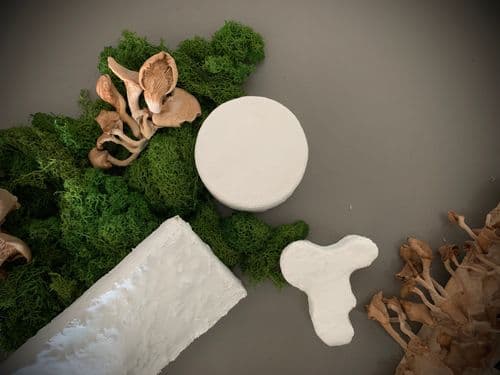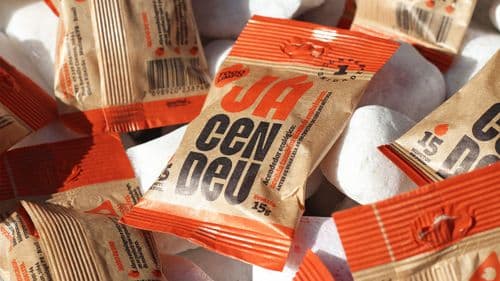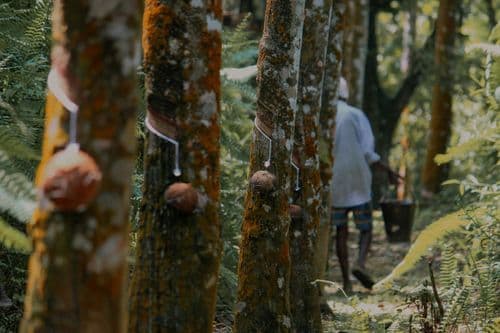Key Points
- Kapok trees grow without irrigation, pesticides, or fertilisers; pods are harvested and fibres used with no wet-spinning.
- High carbon benefit: trees can store ~400–800 kg CO₂/year (≈20–40× a typical tree); main footprint is transport and machinery.
- Flocus built automated sorting and founded KRAF to plant trees, ensure farmer income, and embed agroforestry.
- Blending today: up to 45% in yarns, 80–90% in nonwovens, and 100% in stuffing; a 30% kapok/poly T-shirt could save ~4 kg CO₂.
- Trade-offs: colour fastness and durability closer to cotton than polyester; active R&D to increase kapok share in blends.
Full interview with Flocus
How did the idea of starting the Flocus brand come about? What was the opportunity for change that spurred the creation?
In 2013, my husband and I stumbled upon the remarkable kapok tree by chance on a holiday in Bali Indonesia, which turned out to be one of our lives’ most transformative experiences.
The tree, with its rich history, has recently received little attention from the agricultural and textile industries. After digging into the research, we were astonished to find that kapok was virtually absent from textile narratives, seemingly forgotten, and deemed irrelevant.
We dedicated some time to research purely out of curiosity. We learned that the kapok tree is regenerative without the need for irrigation water, pesticides, fertilizers, or cutting of the trees. Its fiber boasts exceptional qualities such as buoyancy, resistance to moths and mites, hypoallergenic properties, and outstanding insulation and thermal regulation. Moreover, these attributes are inherent to fibers without human intervention. This sparked our curiosity, and we saw an enormous potential for promising substitutes for synthetic materials, animal-based fibers, and other agriculturally intensive natural fibers at times when finding regenerative alternatives to fossil fuel products is essential for our planet.
We decided not to let this extraordinary resource fade into obscurity; we made it our mission to bring kapok back into the spotlight within the textile industry. The goal was to create innovative products that had not been previously considered. We successfully patented a revolutionary processing method for spinning yarns and non-woven paddings for insulation.
This breakthrough enabled the establishment of the textile company Flocus in 2016, specializing in the production of yarns, fabrics, and nonwovens. However, our vision extended beyond mere commercial success, and we aimed to give everyone access to this amazing material.
Recognizing the antiquated and labor-intensive nature of the existing supply chain, we were compelled to address the social and environmental implications of our venture. Sustainability and social responsibility should be integral components of our operations. Therefore, we embarked on an ambitious endeavor to establish the first automated facility for kapok sorting. This pioneering initiative not only introduced corporate social responsibility into the kapok market but also unlocked unprecedented scalability for the fiber, ensuring previously unattainable volumes.
By integrating automation and ethical considerations into our processing methods, we redefined industry standards while fostering a more sustainable and socially conscious approach to textile production.
As a result of increasing fiber demand, we boosted the planting of more trees through the non-profit organization KRAF, which I founded in 2021. KRAF relies on donations from Flocus and its clients to provide free trees to local communities and farmers, who are then guaranteed a yearly income from the sale of kapok pods. Additionally, KRAF assists these farmers in learning how to benefit from intercropping around kapok trees, as well as forming ties with other local farmers and integrating income with other practices, such as bee associations and implementing silvopasture practices.
How does the carbon footprint of kapok fiber production compare to that of conventional textiles?
Kapok fiber production offers a potentially significant offset in terms of its carbon footprint compared with conventional textiles. The tree from which the pods are collected has a minimal environmental impact, as it does not require any human intervention. Additionally, the fiber is already in its fiber form, so there is no wet spinning procedure required or water to clean it. The primary contributors to the carbon footprint in Flocus™ kapok fiber production are the transportation of pods to processing facilities and the energy used to operate machinery.
One notable environmental benefit of kapok trees is their capacity to store substantial amounts of carbon dioxide. These trees can store approximately 400–800 kg of CO2 per year, which is equivalent to 20–40 times the CO2 absorption of a typical tree. Furthermore, kapok trees do not require agricultural land and thrive on marginal lands, and they are a non-food crop.
In summary, when considering the entire lifecycle from tree to fiber production, kapok fiber has a significantly lower carbon footprint than conventional textiles.
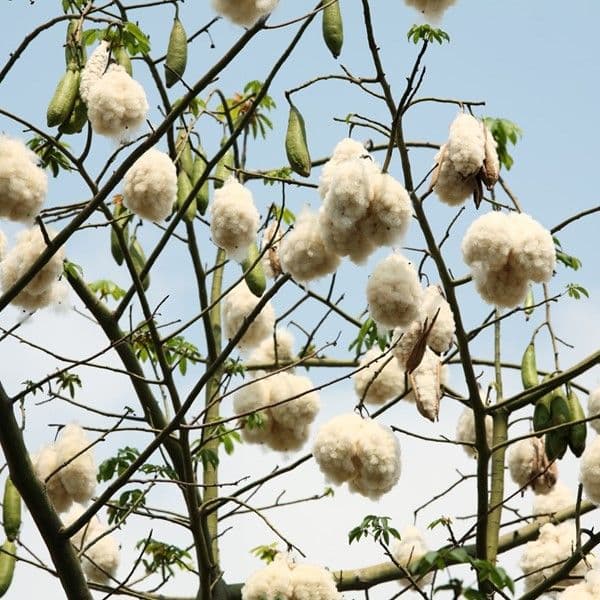
When the demand for Flocus increases, what measures are in place to ensure the prosperity of kapok trees and their renewability in the long term?
The demand for Flocus™ kapok fiber has led to an increased demand for planting trees and ensuring their prosperity without heavy human input. This is achieved through various methods, such as maintaining interest for local people, benefiting locals, and creating the opportunity for them to implement kapok with other local crops, utilizing the trees as crop shading elements or bush fire retardants.
One initiative to address the need to plant trees is the non-profit organization KRAF, which was initiated in 2021. KRAF operates with donations from Flocus™ and its clients, providing free trees to local communities and farmers. This initiative ensures that the trees are planted using regenerative and agroforestry methods, along with Flocus™ guarantee of a yearly income coming from the sales of kapok pods.
In pursuit of our ultimate goal, we are dedicated to planting kapok trees in regions around the equator to foster a resilient landscape. Our vision involves multiplying our factories wherever possible by regeneratively planting kapok trees, which is essential for the sustainability and biodiversity of the ecosystems they inhabit.
How does blending Flocus™ with synthetic fibers like recycled polyester impact the overall sustainability of the product?
The versatile properties of Flocus™ kapok make it a perfect substitute for polyesters or recycled poly in yarns and stuffing. Flocus™ has achieved blending kapok up to 45% in yarns, 80/90% in nonwovens, and 100% in stuffing, significantly reducing the need for fossil-fuel-based fibers. Despite the challenges posed by the short-fiber staple of kapok, Flocus™ is investing in research and development to increase the percentage of kapok in blends. By incorporating kapok fibers into blends with poly or recycled poly, Flocus™ kapok aims to decrease the dependency of the textile industry on fossil fuel-based fibers and reduce its environmental impact. For example, a polyester t-shirt requires 13.2 kg of CO2 to produce by blending just 30% of FLOCUS™kapok in a polyester t-shirt we could save 4 kg of CO2
When blending Flocus™ kapok with synthetic fibers such as recycled polyester, there are trade-offs to consider. Although Flocus™ kapok offers sustainability benefits, it may have limitations in terms of color fastness and durability compared to polyesters. The durability of Flocus™ kapok can be likened to that of cotton but may not reach the same level as that of polyester.
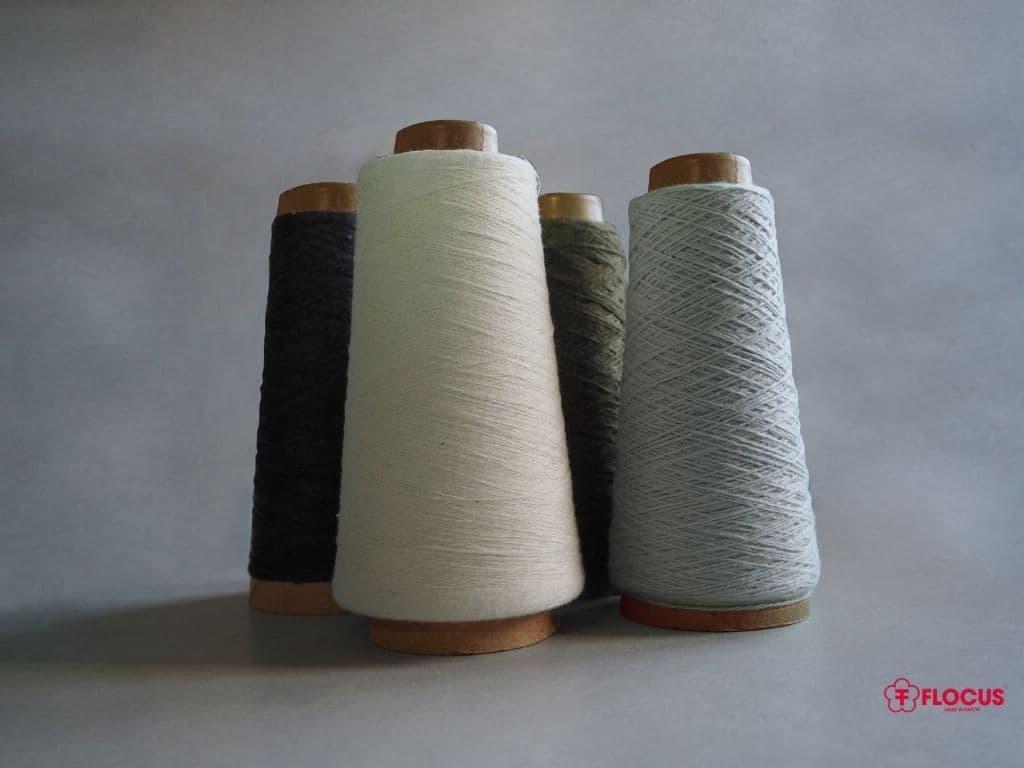
How do you perceive the overall textile industry's adoption of sustainable materials?
The overall adoption of sustainable materials by the textile industry has been a slow but steadily growing trend. As consumers become more conscious of the environmental impacts of their purchases, there is an increasing demand for sustainable and eco-friendly textiles. However, the industry faces challenges in meeting these demands, as brands expect the same properties, volumes, certifications, distribution, and price from new natural materials such as kapok to be at the same level of price and performance as those of petroleum-based mass-market or intensively cultivated natural products, putting small/new companies under a lot of pressure instead of contributing to the acceleration of developments and applications.
Despite these challenges, there are opportunities for more widespread integration of sustainable materials into the textile industry. In my opinion, the solution lies in New Objective policies from leading governments that are based on the nature of the products.
Providing consumers with objective information to make informed decisions about purchasing sustainable materials without hidden agendas, such as greenwashing, can empower them to make a change and do it quickly.
Could you take us through the magical journey from tree to textile and how this fairy tale process sets Flocus apart from traditional fabrics like cotton?
The journey from tree to textile for Flocus™ kapok is indeed a magical one. The key difference lies in the agricultural processes. The Kapok tree stands for approximately 100 years without being cut or replaced, absorbing a significant amount of CO2. Unlike traditional fibers such as cotton, kapok does not require intensive cultivation or agricultural land, making it suitable for intercropping and eliminating the need for monocropping.

Essentially, the pods are collected from the tree and transported into the Flocus™ sorting facility, where the pods are mechanically opened and all the elements of the pods are separated. At the end of the line, all elements are packed, and the clean fibers are bailed and distributed to be used in their original form for stuffing or in mills for spinning, weaving and making nonwoven sheets.
The reason that kapok was forgotten essentially comes down to two main factors.
It was widely used and internationally traded during the Dutch colonization of Indonesia, finding applications in many high-value products. However, with the invention of polyester, a cheaper and faster alternative, kapok has been discarded, substituted, and essentially forgotten.
Second, the outdated supply chain contributed to its decline. When we (re)discovered it in 2013, we found that the supply chain was still operating at the same level as it had been in the 1800s, lacking social responsibility, safety standards, and proper working conditions for laborers. Therefore, Flocus™ established the first automated facility for kapok sorting, automating and modernizing the process, enabling larger volumes to be produced while ensuring social compliance.

